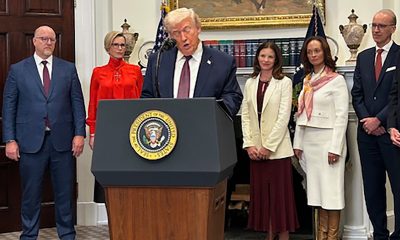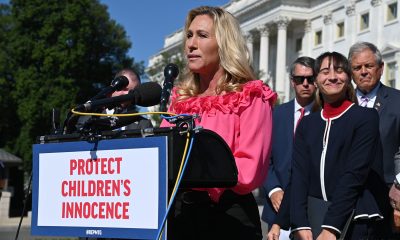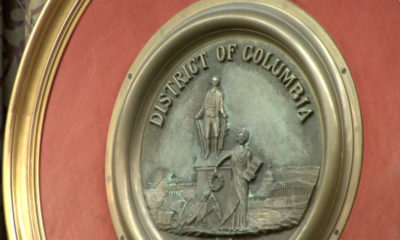National
The story behind the Harvey Milk stamp
Postal service to release commemorative stamp in May
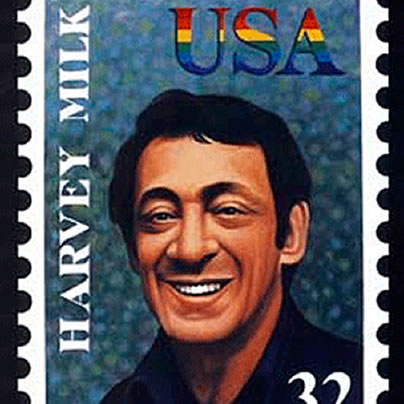
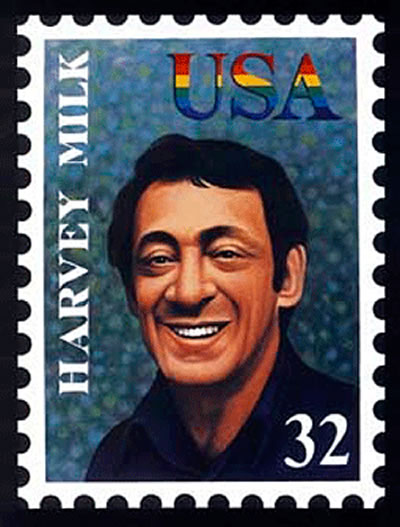
The Harvey Milk commemorative stamp is set to be released this spring.
While no specific date has been announced for the official release of the United States Postal Service’s first-ever Harvey Milk stamp, the Washington Blade has confirmed that the release date will be in May—not as late as June, as has been reported by several media outlets and as the postal service’s own Web site still indicates is possible.
“It will be May, not June,” said Susan McGowan, director of USPS Office of Stamps and Corporate Licensing. “And we hope people will turn out to experience a very special release ceremony.”
The stamp’s coming out party promises to be a big affair for the postal service—one that’s been nearly a decade in the making.
“Let’s just say it’s going to be a great celebration,” McGowan told the Blade.
Today, Harvey Milk may seem like a shoe-in as a candidate to be honored with the issuance of a U.S. postage stamp bearing his likeness.
But according to organizers of the National Harvey Milk Stamp Campaign, there was fervent opposition from some of the country’s most fundamentalist religious groups, as well as from some members of the Citizens Stamp Approval Committee (CSAC), which votes to approve about 25 stamp requests out of about 1,000 requests each year.
“I know for a fact that some of the stamp committee members were absolutely opposed to the idea of a Harvey Milk stamp or a stamp honoring any homosexual leader,” said San Diego City Commissioner Nicole Murray Ramirez, head of the International Imperial Court System, which led the national campaign to win approval for the stamp.
“That was early on, of course. I think as the process moved on and they saw how much support we had not only from Democrats, but from top Republicans, support grew.”
Although she couldn’t say whether the Citizens Stamp Approval Committee’s vote for the Harvey Milk stamp was divided or unanimous, USPS’s McGowan was adamant that there is no story of impassioned opposition to the stamp on the committee.
“I think you’re trying to find controversy where there wasn’t any,” she said. “It’s quite possible the vote was unanimous; we don’t keep those details because all that is needed is a simple majority for approval.”
What matters, says McGowan, is that the committee did approve the Harvey Milk stamp, and that it will be released in May.
Ramirez said the process for winning approval for the Harvey Milk stamp was arduous. But he added that he and his colleagues on the stamp campaign, including Stuart Milk — Harvey Milk’s nephew who is also a gay civil rights advocate — GLAAD, the Human Rights Campaign, the Harvey Milk Foundation, the National Gay and Lesbian Task Force, numerous senators and members of Congress, mayors and others, were gratified that it succeeded.
“I don’t think it was as hard as it would have been 20 years ago,” Ramirez said. “In the end, I think we were treated fairly and we got approval for the stamp faster than a lot of other stamp campaigns.”
Still, some organizations such as Save California, a right-wing religious group, plan to protest the postal service’s decision to commemorate Harvey Milk, whom they call a “sexual predator.”
Nevertheless, Ramirez said national symbols, such as commemorative stamps, speak louder and resound for longer than any words of hate or bigotry espoused by angry ultra-conservatives.
“The fact that we now have the image of one of our greatest GLBT leaders on a beautifully designed United States postage stamp says more than anything else about how far we have come as a country fighting against the hatred that we still face as gay, lesbian, bisexual and transgender people,” said Ramirez.
Ramirez knows about that history through his own experience. He helped lead historic marches for LGBT rights in the early 1970s in downtown San Diego and other California locales to protest police abuse of gay people.
“Young people don’t know how bad it was,” Ramirez said. “You could get beat up or worse by the police, just for being in a gay bar. This stamp honoring Harvey Milk shows that by fighting for our rights and never giving up, we can change the way the majority of people behave toward minorities, whether it’s racial minorities or GLBT people.”
According to McGowan, the postal service received thousands of letters of support for the Milk stamp.
“It was overwhelming,” she said. “We get about 30,000 letters of support for stamp proposals every year, but that’s for all of the thousand or so annual stamp proposals combined. The amount of public support for this stamp was really amazing.”
The stamp campaign began with a simple letter, dated Oct. 20, 2009, signed by Ramirez in his capacity then as chair of the City of San Diego’s Human Relations Commission, asking the Citizens Stamp Approval Committee to consider and approve the design and issuance of a U.S. postage stamp commemorating and bearing an image of San Francisco City and County Supervisor Harvey Milk.
In essence, the Harvey Milk campaign asked the postal service for the first time to specifically honor a person for being a tireless soldier in the battle for equal rights for LGBT people—and for having the courage and tenacity to become one of the nation’s first openly gay elected public officials.
Ramirez and his fellow signers of the San Diego Human Relations Commission’s letter to CSAC wrote in 2009: “The governor of the state of California, Arnold Schwarzenegger, recently inducted Harvey Milk into the California Hall of Fame, saying ‘he embodies California’s innovative spirit and has made a mark on history.”
By citing California’s then Republican governor’s support for the stamp, the campaign hoped to demonstrate the principles Milk stood for crossed party lines.
“Harvey Milk is recognized nationally and globally as a pioneer of the LGBT civil rights movement for his exceptional leadership and dedication to equal rights,” the letter continued.
That same year, the film “Milk” won Sean Penn an Oscar for best actor in recognition of his critically acclaimed portrayal of the slain civil rights leader. The hit film also brought home an Oscar for writer Dustin Lance Black for best screenplay.
That was also the year that President Obama posthumously awarded Harvey Milk the Presidential Medal of Freedom.
Now, five years later, a postage stamp featuring Milk’s smiling face will finally be released. The stamp will find its way into the stamp collections of philatelists throughout the world.
According to one gay stamp collector, given the fact that this is the first stamp expressly honoring an openly gay American hero, it is conceivable that the postal service may get a whole new generation of LGBT philatelists as stamp-collecting customers.
“Harvey Milk continues to inspire us all to strive for a society that provides unlimited and equal opportunities for all our citizens,” wrote Rep. Nancy Pelosi to CSAC when she was still speaker of the House of Representatives, imploring the committee to approve the stamp. “The United States Postal Service has yet to honor an LGBT American hero with a stamp, commemorating the life and efforts of Harvey Milk would be a testament to Harvey’s courage and a symbol of pride to anyone who has ever felt discrimination or cared about those who have.”
Recently, a new stamp campaign was launched for another openly gay Presidential Medal of Freedom recipient.
In January, the Blade broke the news that many of the same people and organizations that won approval for the Harvey Milk stamp have joined with Walter Naegle, Mandy Carter and the National Black Justice Coalition (which Carter cofounded), to win approval for a United States postage stamp commemorating the life and work of the late Bayard Rustin.
Along with A. Phillip Randolph, Rustin was chief organizer of the 1963 March on Washington for Freedom and Jobs, where Martin Luther King, Jr. delivered his historic “I Have a Dream” speech.
“The current campaign is a new effort, but there have been letters written for more than a decade suggesting that Bayard be honored with a stamp,” said Walter Naegle, Rustin’s surviving partner. “Perhaps an increase in the number of supporters will help, but the postal service doesn’t seem to be influenced by such efforts.”
Naegle is currently engaged in an ongoing Rustin awareness campaign, focusing his efforts on a multitude of fronts. He promises to do what he can to help the Bayard Rustin National Stamp Campaign succeed.
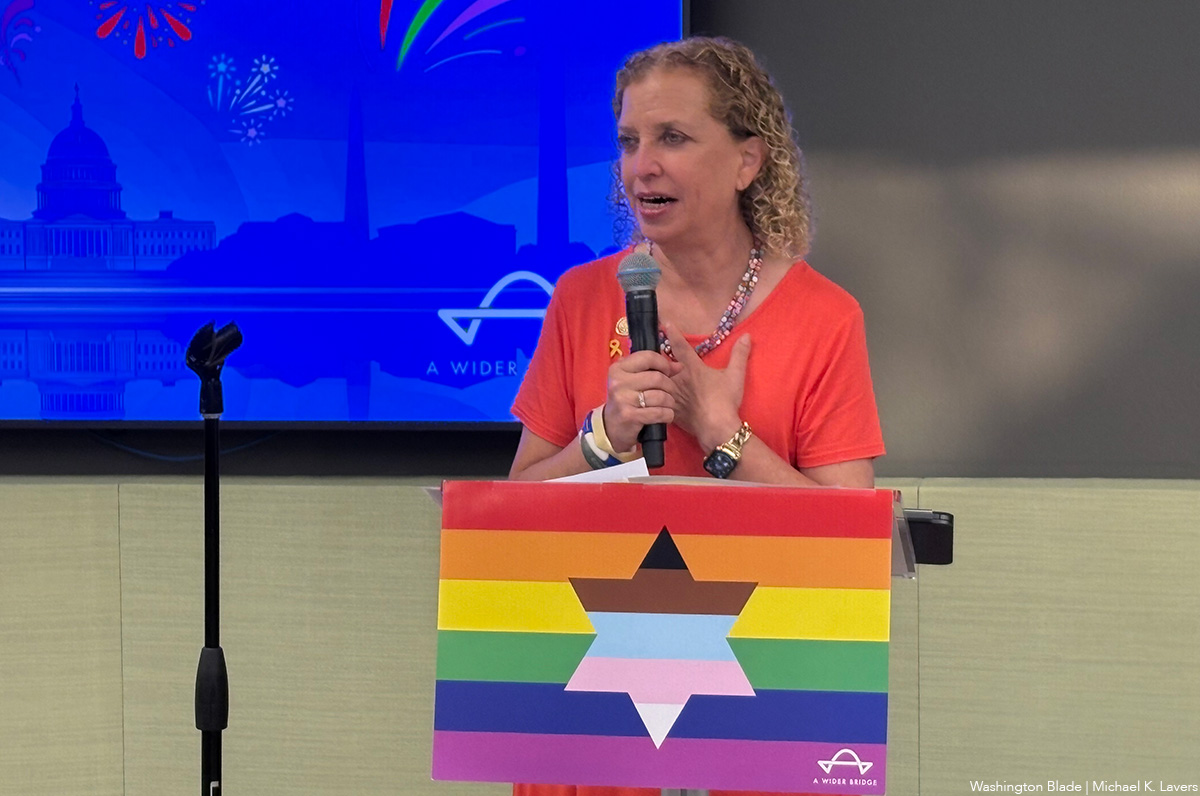
A Wider Bridge on Friday announced it will shut down at the end of the month.
The group that “mobilizes the LGBTQ community to fight antisemitism and support Israel and its LGBTQ community” in a letter to supporters said financial challenges prompted the decision.
“After 15 years of building bridges between LGBTQ communities in North America and Israel, A Wider Bridge has made the difficult decision to wind down operations as of Dec. 31, 2025,” it reads.
“This decision comes after challenging financial realities despite our best efforts to secure sustainable funding. We deeply appreciate our supporters and partners who made this work possible.”
Arthur Slepian founded A Wider Bridge in 2010.
The organization in 2016 organized a reception at the National LGBTQ Task Force’s Creating Change Conference in Chicago that was to have featured to Israeli activists. More than 200 people who protested against A Wider Bridge forced the event’s cancellation.
A Wider Bridge in 2024 urged the Capital Pride Alliance and other Pride organizers to ensure Jewish people can safely participate in their events in response to an increase in antisemitic attacks after Hamas militants attacked Israel on Oct. 7, 2023.
The Jewish Telegraphic Agency reported authorities in Vermont late last year charged Ethan Felson, who was A Wider Bridge’s then-executive director, with lewd and lascivious conduct after alleged sexual misconduct against a museum employee. Rabbi Denise Eger succeeded Felson as A Wider Bridge’s interim executive director.
A Wider Bridge in June honored U.S. Rep. Debbie Wasserman Schultz (D-Fla.) at its Pride event that took place at the Capital Jewish Museum in D.C. The event took place 15 days after a gunman killed two Israeli Embassy employees — Yaron Lischinsky and Sarah Milgrim — as they were leaving an event at the museum.
“Though we are winding down, this is not a time to back down. We recognize the deep importance of our mission and work amid attacks on Jewish people and LGBTQ people – and LGBTQ Jews at the intersection,” said A Wider Bridge in its letter. “Our board members remain committed to showing up in their individual capacities to represent queer Jews across diverse spaces — and we know our partners and supporters will continue to do the same.”
Editor’s note: Washington Blade International News Editor Michael K. Lavers traveled to Israel and Palestine with A Wider Bridge in 2016.
The White House
‘Trump Rx’ plan includes sharp cuts to HIV drug prices
President made announcement on Friday

President Donald Trump met with leaders from some of the world’s largest pharmaceutical companies at the White House on Friday to announce his new “Trump Rx” plan and outline efforts to reduce medication costs for Americans.
During the roughly 47-minute meeting in the Roosevelt Room, Trump detailed his administration’s efforts to cut prescription drug prices and make medications more affordable for U.S. patients.
“Starting next year, American drug prices will come down fast, furious, and will soon be among the lowest in the developed world,” Trump said during the meeting. “For decades, Americans have been forced to pay the highest prices in the world for prescription drugs by far … We will get the lowest price of anyone in the world.”
Trump signed an executive order in May directing his administration “to do everything in its power to slash prescription drug prices for Americans while getting other countries to pay more.”
“This represents the greatest victory for patient affordability in the history of American health care, by far, and every single American will benefit,” he added.
Several pharmaceutical executives stood behind the president during the announcement, including Sanofi CEO Paul Hudson, Novartis CEO Vas Narasimhan, Genentech CEO Ashley Magargee, Boehringer Ingelheim (USA) CEO Jean-Michel Boers, Gilead Sciences CEO Dan O’Day, Bristol Myers Squibb General Counsel Cari Gallman, GSK CEO Emma Walmsley, Merck CEO Robert Davis, and Amgen Executive Vice President Peter Griffith.
Also in attendance were Health and Human Services Secretary Robert F. Kennedy Jr., Commerce Secretary Howard Lutnick, Centers for Medicare and Medicaid Services Administrator Mehmet Oz, and Food and Drug Administration Commissioner Marty Makary.
Under the Trump Rx plan, the administration outlined a series of proposed drug price changes across multiple companies and therapeutic areas. Among them were reductions for Amgen’s cholesterol-lowering drug repatha from $573 to $239; Bristol Myers Squibb’s HIV medication reyataz from $1,449 to $217; Boehringer Ingelheim’s type 2 diabetes medication jentadueto from $525 to $55; Genentech’s flu medication xofluza from $168 to $50; and Gilead Sciences’ hepatitis C medication epclusa from $24,920 to $2,425.
Additional reductions included several GSK inhalers — such as the asthma inhaler advair diskus 500/50, from $265 to $89 — Merck’s diabetes medication januvia from $330 to $100, Novartis’ multiple sclerosis medication mayzent from $9,987 to $1,137, and Sanofi’s blood thinner plavix from $756 to $16. Sanofi insulin products would also be capped at $35 per month’s supply.
These prices, however, would only be available to patients who purchase medications directly through TrumpRx. According to the program’s website, TrumpRx “connects patients directly with the best prices, increasing transparency, and cutting out costly third-party markups.”
Kennedy spoke after Trump, thanking the president for efforts to lower pharmaceutical costs in the U.S., where evidence has shown that drug prices — including both brand-name and generic medications — are nearly 2.78 times higher than prices in comparable countries. According to the Pharmaceutical Research and Manufacturers of America, roughly half of every dollar spent on brand-name drugs goes to entities that play no role in their research, development, or manufacturing.
“This is affordability in action,” Kennedy said. “We are reversing that trend and making sure that Americans can afford to get the life-saving solutions.”
Gilead CEO Dan O’Day also spoke about how the restructuring of drug costs under TrumpRx, combined with emerging technologies, could help reduce HIV transmission — a virus that, if untreated, can progress to AIDS. The LGBTQ community remains disproportionately affected by HIV.
“Thank you, Mr. President — you and the administration,” O’Day said. “I think this objective of achieving the commitment to affordability and future innovation is extraordinary … We just recently launched a new medicine that’s only given twice a year to prevent HIV, and we’re working with Secretary Kennedy and his entire team, as well as the State Department, as a part of your strategy to support ending the epidemic during your term.
“I’ve never been more optimistic about the innovation that exists across these companies and the impact this could have on America’s health and economy,” he added.
Trump interjected, asking, “And that’s working well with HIV?”
“Yes,” O’Day replied.
“It’s a big event,” Trump said.
“It literally prevents HIV almost 100 percent given twice a year,” O’Day responded.
A similar anti-HIV medication is currently prescribed more than injectable form mentioned by O’Day. PrEP, is a medication regimen proven to significantly reduce HIV infection rates for people at high risk. Without insurance, brand-name Truvada can cost roughly $2,000 per month, while a generic version costs about $60 per month.
Even when medication prices are reduced, PrEP access carries additional costs, including clinic and laboratory fees, office visits, required HIV and sexually transmitted infection testing, adherence services and counseling, and outreach to potentially eligible patients and providers.
According to a 2022 study, the annual total cost per person for PrEP — including medication and required clinical and laboratory monitoring — is approximately $12,000 to $13,000 per year.
The TrumpRx federal platform website is now live at TrumpRx.gov, but the program is not slated to begin offering reduced drug prices until January.
The White House
EXCLUSIVE: Democracy Forward files FOIA lawsuit after HHS deadnames Rachel Levine
Trans former assistant health secretary’s name changed on official portrait

Democracy Forward, a national legal organization that works to advance democracy and social progress through litigation, policy and public education, and regulatory engagement, filed a lawsuit Friday in federal court seeking to compel the U.S. Department of Health and Human Services to release information related to the alteration of former Assistant Secretary for Health Adm. Rachel Levine’s official portrait caption.
The lawsuit comes in response to the slow pace of HHS’s handling of multiple Freedom of Information Act requests — requests that federal law requires agencies to respond to within 20 working days. While responses can take longer due to backlogs, high request volumes, or the need for extensive searches or consultations, Democracy Forward says HHS has failed to provide any substantive response.
Democracy Forward’s four unanswered FOIA requests, and the subsequent lawsuit against HHS, come days after someone in the Trump-Vance administration changed Levine’s official portrait in the Hubert H. Humphrey Building to display her deadname — the name she used before transitioning and has not used since 2011.
According to Democracy Forward, HHS “refused to release any records related to its morally wrong and offensive effort to alter former Assistant Secretary for Health Admiral Rachel Levine’s official portrait caption.” Levine was the highest-ranking openly transgender government official in U.S. history and served as assistant secretary for health and as an admiral in the U.S. Public Health Service Commissioned Corps from 2021 to 2025.
Democracy Forward President Skye Perryman spoke about the need to hold the Trump-Vance administration accountable for every official action, especially those that harm some of the most targeted Americans, including trans people.
“The question every American should be asking remains: what is the Trump-Vance administration hiding? For an administration that touts its anti-transgender animus and behavior so publicly, its stonewalling and silence when it comes to the people’s right to see public records about who was behind this decision is deafening,” Perryman said.
“The government’s obligation of transparency doesn’t disappear because the information sought relates to a trailblazing former federal official who is transgender. It’s not complicated — the public is entitled to know who is making decisions — especially decisions that seek to alter facts and reality, erase the identity of a person, and affect the nation’s commitment to civil rights and human dignity.”
“HHS’s refusal to respond to these lawful requests raises more serious concerns about transparency and accountability,” Perryman added. “The public has every right to demand answers — to know who is behind this hateful act — and we are going to court to get them.”
The lawsuit also raises questions about whether the alteration violated federal accuracy and privacy requirements governing Levine’s name, and whether the agency improperly classified the change as an “excepted activity” during a lapse in appropriations. By failing to make any determination or produce any records, Democracy Forward argues, HHS has violated its obligations under federal law.
The case, Democracy Forward Foundation v. U.S. Department of Health and Human Services, was filed in the U.S. District Court for the District of Columbia. The legal team includes Anisha Hindocha, Daniel McGrath, and Robin Thurston.
The Washington Blade reached out to HHS, but has not received any comment.
The lawsuit and four FOIA requests are below:
-

 Politics4 days ago
Politics4 days agoLGBTQ Democrats say they’re ready to fight to win in 2026
-

 District of Columbia4 days ago
District of Columbia4 days agoBrian Footer suspends campaign for Ward 1 D.C. Council seat
-

 Opinions4 days ago
Opinions4 days agoLighting candles in a time of exhaustion
-

 Opinions4 days ago
Opinions4 days ago2026 elections will bring major changes to D.C. government

